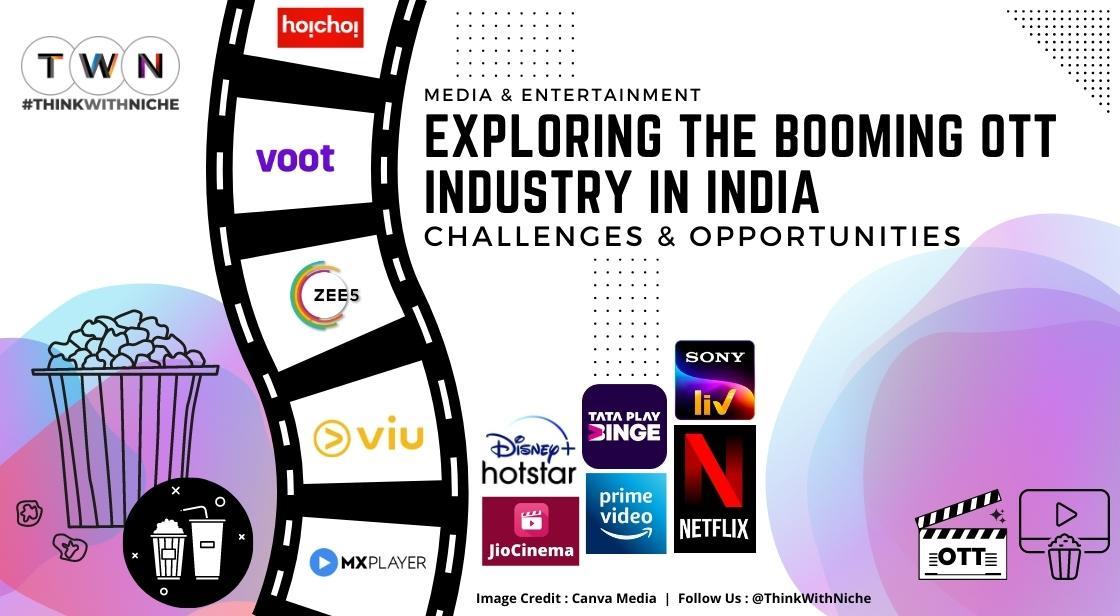Exploring The Booming OTT Industry In India - Challenges And Opportunities

Blog Post
The OTT media services market in India has doubled in size during the last four years. Online media services provided directly to viewers are known as over-the-top (OTT) media services. A rise in faster internet speeds and a rise in consumer demand for a wider range of media services, such as sports, entertainment, and movies, have occurred at the same time as its global spread.
In many countries, particularly in the West, OTT has replaced traditional TV broadcasters as the main source of screen-based entertainment.
These services have replaced scheduled broadcasts with on-demand content. India increased the cap on Foreign Direct Investment (FDI) from 74% to 100% for the media and entertainment sector in the meantime. In this blog, we will be Exploring The Booming OTT Industry In India - Challenges And Opportunities.
Paying for entertainment is a challenge in the Indian market. The consumption of digital content is rapidly increasing as a result of the widespread availability of smart devices and affordable pricing mobile data plans. The way Indians consume content has certainly changed since they switched from Doordarshan to Direct-to-Home (D2H) to OTT platforms. Over-the-top (OTT) consumers in India spend about 70 minutes per day on video streaming platforms, with a consumption frequency of 12.5 times per week, according to an Eros Now-KPMG survey!
In this article, we look into the consistent changes that OTT is making to the dynamics of the Indian media and entertainment industry.
Exploring The Booming OTT Industry In India - Challenges And Opportunities
The definition of OTT
"Over-the-top" refers to going above and beyond streaming on social networks and YouTube. Yes, OTT is streaming. On computers, smartphones, and other OTT devices, this content can be streamed. But "premium" makes a difference. Delivered online are high-quality experiences and content.
What distinguishes OTT from TV?
While TV requires a cable subscription or an antenna, OTT material is directly delivered over the Internet and is paid for by consumers. An important advantage over traditional TV programming is that consumers can stream OTT content whenever and wherever they want.
Origin of OTT Platforms in India
Over-the-top, or OTT, refers to content that is provided in addition to cable networks or YouTube. Reliance Entertainment introduced BIGFlix, the country's first independent OTT platform, in 2008.
The first OTT mobile app in India was released in 2010 by Gurugram-based Digivive under the name nexGTv. It provides on-demand and live TV. In 2013 and 2014, nexGTV was the first app to live stream Indian Premier League matches on mobile devices. Following its 2015 acquisition of the rights to stream the IPL live, Hotstar has experienced significant growth in India.
SonyLiv and DittoTV (Zee) both enjoyed significant growth in India when they first entered the market there in 2013. DittoTV was a platform that combined content from many media networks, such as Star, Sony, Viacom, Zee, etc.
Currently, there are about 46 companies in India that offer over-the-top media services and online content delivery.
How large is the Indian OTT market?
The rapid growth of video cassette recorders and players (VCRs/VCPs) in the 1980s disrupted the conventional methods of watching movies. However, the growth of multiplexes in major cities in the early 2000s had already done away with single screens and the DVD industry. Multiplexes are currently suffering as a result of the emergence of OTT platforms.
The Indian OTT streaming video industry is currently in its second development phase, with total revenues expected to reach $3 billion in 2022, according to a survey done by Media Partners Asia (MPA). 7-9% of the revenue and market share of the entertainment business are currently controlled by OTT. The business is expanding quickly and steadily, with over 40 players providing original content in all languages. Currently, India has about 45 million OTT customers. By the end of 2023, this number is anticipated to reach 50 million.
The OTT market is anticipated to develop from 2,590 crores in 2018 to a $12,000 crore sector by 2023 at a compound annual growth rate of 36%.
Also Read: 12 Best Free online Movie Streaming Apps To Checkout In 2023
Reasons for OTT Platforms' Fast Growth
The huge popularity of OTT in India has been largely attributed to the quick adoption and growth of internet infrastructure. These features allow OTT services to bypass traditional distribution and media networks and provide content directly to viewers.
Due to the Covid-19 pandemic, which kept people inside their homes, OTT platforms were more popular and accepted. People have used it to get over boredom.
OTT platforms offer more than simply mobile media viewing options. For a fair price, one can access ad-free services and download videos in a variety of languages to watch them offline on their devices.
Many movies and TV shows can be watched on streaming services before they are broadcast on television. It is the ideal venue for newcomers who are passionate about movies or web series to amplify their passion.
To build a loyal following and subscription base, OTT platform operators must offer a seamless viewing experience across a variety of devices. The multi-screen OTT experience is another important element that has helped the streaming industry's customer base continue to expand.
Fresh and high-quality content People are drawn to these platforms because they are sick of the traditional Indian TV serials, which run on for what seems like eternity.
OTT offers chances for producers and artists who had lost their prominence as a result of changes in entertainment or movie. Many people have regained their prominence.
Challenges with OTT Platforms
For OTT platforms, the two biggest problems are security and privacy. Users' sign-in or search history data maintained on their platforms shouldn't be used for illegal purposes.
Another problem with OTT services is that they are not censored. There are several types of inappropriate content that kids can encounter. Poor internet connections will prevent users from having a smooth viewing experience.
Due to the wide variety of content offered by OTT platforms, viewers may easily become addicted, leading to a reduced social life. Another significant problem with OTT platforms' profitability is password sharing.
Piracy is costing OTT providers up to 30% of their annual income as more users utilise digital platforms to stream content. As soon as they are released in OTT, these unauthorized websites offer a variety of digital entertainment.
For viewers, the ad-free content offered by OTT services is a major plus. This, however, seems to be changing as Netflix now seeks to incorporate advertisements to increase revenue. Because they are paying for premium services and will be unable to avoid advertisements, this will be problematic for viewers.
Different OTT Platforms in India
There are now many OTT service possibilities available to Indians. The well-known OTT providers include Netflix, Amazon Prime Video, Disney+ Hotstar, ALTBalaji, Zee 5, Aha, Voot, SonyLIV, Viu, Hoichoi, etc. All of these platforms have different subscription options and device compatibility.
Despite the dominance of Hotstar and Amazon Prime Video in the OTT space, aggregated OTT providers like TATA Play Binge have experienced exponential development. More than 16 apps, including Disney+ Hotstar, MX Player, Voot, Zee5, and SonyLIV, are accessible through it. The dominance of Netflix and Amazon Prime could be threatened by the mergers of ZEEL and Sony, Jio Cinema OTT, and Viacom 18 Media.
Future of Indian OTT Platforms
One of India's industries with the quickest growth is media and entertainment. However, it can be challenging to stay up with shifting consumer demands and changing content trends.
The likelihood of consumers watching a variety of information whenever and wherever they choose has increased. In a survey conducted by Ascent Group India, 68.9% of customers said they preferred watching OTT content over more conventional forms of entertainment. As a result of people choosing to stay at home during the pandemic, OTT platform usage increased. OTT platforms have increased their user base because of their fantastic marketing strategies.
India's diversity offers sufficient opportunity for nearly every current OTT player as well as those looking to break into a sector other than entertainment. Because of this, traditional content producers and platforms are steadily dying off while OTT platforms are only getting started.
It will be interesting to see how OTT platforms adapt to the changing demands and behaviors of consumers and whether they too go through a slowdown. What OTT platforms have you registered with?
You May Like
EDITOR’S CHOICE












